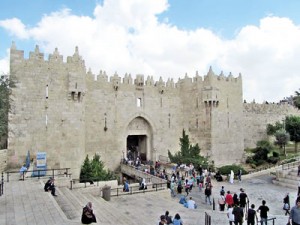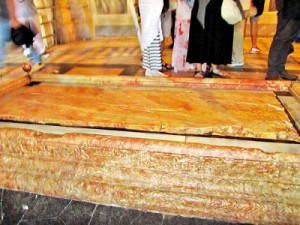Jerusalem – Seeing and being in the presence of a sacred city
Having entered the old city through the famed Damascus Gate I strolled down Al-Wad Street, the narrow stepped way sloping down towards the Via Dolorosa.
On either side of this constricted street were stalls selling not only souvenirs and clothes but also foods ranging from sticky baklavas and ice creams to delicious falafels and lamb slow- roasting spits.

The Damascus Gate and top, the marble slab at the Church of the Holy Sepulchre
This was Jerusalem – a fascinating city that excites one’s imagination, a city within whose ancient walls the old and the new as well as the secular and the sacred are juxtaposed.Unique in its beauty as well as its holiness, this is a city that is home to three of the world’s major religions.
Jerusalem has existed as a city from around a thousand years BCE when Israel’s King David (the one who killed the giant Goliath) made it his capital.
Over the centuries it has been conquered by Jews, Greeks, Romans, Byzantines, Crusaders, Ottomans and the British – and all of these rulers have left their mark on the city.
Today, the area within the massive defensive walls (referred to as The Old City) is roughly divided into Muslim, Jewish, Christian and Armenian Quarters – each of which regions has its distinct features and yet is part of a whole in which the various inhabitants get about their activities of daily living within what is in effect an open air museum of history.
Within the Muslim Quarter are various Christian churches and monasteries – and the famed Via Dolorosa, the “Way of Sorrow” along which Jesus Christ was forced to walk, carrying his heavy cross, to the site of his execution.
The route is marked by fourteen ‘Stations of the Cross’ commemorating events that took place during Christ’s final fateful journey. The Way of Sorrow ends in the centre of the Christian Quarter at one of Christianity’s most hallowed shrines – the Church of the Holy Sepulchre, built at the site of Christ’s crucifixion and burial.
The original Jewish Temple built by King Solomon and rebuilt by King Herod in the first century BCE occupied the vast esplanade in the south-eastern part of the city which is known these days as the Temple Mount or Haram esh-Sarif (an Arabic phrase meaning ‘Noble Sanctuary’).
The temple itself was destroyed by the Romans in 70 AD, the only part left standing being its Western Wall. This massive blank wall, constructed from huge rectangular stone blocks, is today considered one of Judaism’s holiest sites.
The Temple Mount which was the site of the original Jewish temple laid waste by the Romans is now a rectangular esplanade on which stand the magnificent Dome of the Rock and the Al-Aqsa mosque which attracts vast crowds of Muslims for Friday prayers.
This city Jerusalem – where Jesus was crucified, buried and rose from the dead, from which Prophet Mohamed made the Miraj (his ascent through the heavens to God’s presence), where the massive wall of King Solomon’s temple still stands – is considered holy by Christians, Muslims and Jews alike.
Within the sacred city religious pilgrims belonging to all three faiths mingled with secular tourists like myself – while the modern inhabitants of Jerusalem get about their daily lives as their ancestors have been doing for nigh on three thousand years.
I was fascinated by what I saw and felt in Jerusalem.
I watched traditionally clad Jews bowing and praying in front of the Western Wall. I wore a Jewish kippah (skull cap) and visited the tomb of King David and the ornate Sephardic synagogue within the Jewish quarter.
I walked thoughtfully along the Via Dolorosa and joined the throngs at the Church of the Holy Sepulchre, where can be seen the marble slab which covers the place on which Jesus’ body is believed to have been laid after his death.
Although non-Muslims are not permitted to enter the Al Aqsa mosque of the Dome of the Rock, I was able to stroll through the Haram esh-Sharif and admire these magnificent buildings from outside.
During the Six Day war of 1967 Israeli paratroopers captured the eastern half of the city (which was until then under Jordanian control) and the entire city came under Israeli control. This year therefore marked the fiftieth anniversary of the reunification of Jerusalem – celebrated while I was there with a magnificent firework display and a sound and light show outside the city walls.
Jerusalem is a city where the very stones are ancient. It is a city containing so many magnificent monuments to the faiths men live by. It is a city sacred to millions of Jews, Christians and Muslims all over the world. It was a privilege to be here.
For more information, check https://www.touristisrael.com/jerusalem/

The Western Wall


